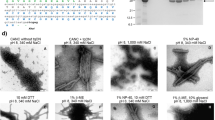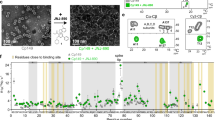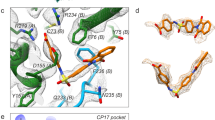Abstract
Virus assembly has not been routinely targeted in the development of antiviral drugs, in part because of the lack of tractable methods for screening in vitro. We have developed an in vitro assay of hepatitis B virus (HBV) capsid assembly, based on fluorescence quenching of dye-labeled capsid protein, for testing potential inhibitors. This assay is adaptable to high-throughput screening and can identify small-molecule inhibitors of virus assembly that prevent, inappropriately accelerate and/or misdirect capsid formation to yield aberrant particles. An in vitro primary screen has the advantage of identifying promising lead compounds affecting assembly without the requirement that they be taken up by cells in culture and be nontoxic. Our approach may facilitate the identification of antivirals targeting viruses other than HBV, such as avian influenza and HIV.
This is a preview of subscription content, access via your institution
Access options
Subscribe to this journal
Receive 12 print issues and online access
$209.00 per year
only $17.42 per issue
Buy this article
- Purchase on Springer Link
- Instant access to full article PDF
Prices may be subject to local taxes which are calculated during checkout




Similar content being viewed by others
References
Previsani, N. & Lavanchy, D. Hepatitis B (Epidemic and Pandemic Alert and Response, World Health Organization, Geneva, 2002). http://www.who.int/csr/disease/hepatitis/whocdscsrlyo20022/en/
Ganem, D. Hepadnaviridae and their replication. in Fields virology (eds. Fields, B.N. et al.) 2703–2737, (Lippincott–Raven Publishers, Philadelphia, 1996).
Summers, J. & Mason, W.S. Replication of the genome of a hepatitis B-like virus by reverse transcription of an RNA intermediate. Cell 29, 403–415 (1982).
Wingfield, P.T., Stahl, S.J., Williams, R.W. & Steven, A.C. Hepatitis core antigen produced in Escherichia coli: subunit composition, conformational analysis, and in vitro capsid assembly. Biochemistry 34, 4919–4932 (1995).
Nassal, M., Rieger, A. & Steinau, O. Topological analysis of the hepatitis B virus core particle by cysteine-cysteine cross-linking. J. Mol. Biol. 225, 1013–1025 (1992).
Zhou, S. & Standring, D.N. Hepatitis B virus capsid particles are assembled from core-protein dimer precursors. Proc. Natl. Acad. Sci. USA 89, 10046–10050 (1992).
Zlotnick, A., Johnson, J.M., Wingfield, P.W., Stahl, S.J. & Endres, D. A theoretical model successfully identifies features of hepatitis B virus capsid assembly. Biochemistry 38, 14644–14652 (1999).
Ceres, P. & Zlotnick, A. Weak protein-protein interactions are sufficient to drive assembly of hepatitis B virus capsids. Biochemistry 41, 11525–11531 (2002).
Stray, S., Ceres, P. & Zlotnick, A. Zinc ions trigger conformational change and oligomerization of hepatitis B virus capsid protein. Biochemistry 43, 9989–9998 (2004).
Stray, S. et al. A heteroaryldihydropyrimidine activates and can misdirect hepatitis B virus capsid assembly. Proc. Natl. Acad. Sci. USA 102, 8138–8143 (2005).
Zlotnick, A. Are weak protein–protein interactions the general rule in capsid assembly? Virology 315, 269–274 (2003).
Singh, S. & Zlotnick, A. Observed hysteresis of virus capsid disassembly is implicit in fundamental kinetic models of association and dissociation. J. Biol. Chem. 278, 18249–18255 (2003).
Weber, O. et al. Inhibition of human hepatitis B (HBV) by a novel non-nucleosidic compound in a transgenic mouse model. Antiviral Res. 54, 69–78 (2002).
Deres, K. et al. Inhibition of hepatitis B virus replication by drug induced depletion of nucleocapsids. Science 299, 893–896 (2003).
Hacker, H., Deres, K., Mildenberger, M. & Schroder, C. Antivirals interacting with hepatitis B virus core protein and core mutations may misdirect capsid assembly in a similar fashion. Biochem. Pharmacol. 66, 2273–2279 (2003).
Zlotnick, A. et al. Localization of the C terminus of the assembly domain of hepatitis B virus capsid protein: implications for morphogenesis and organization of encapsidated RNA. Proc. Natl. Acad. Sci. USA 94, 9556–9561 (1997).
Wynne, S.A., Crowther, R.A. & Leslie, A.G. The crystal structure of the human hepatitis B virus capsid. Mol. Cell 3, 771–780 (1999).
Nassal, M. Conserved cysteines of the hepatitis B virus core protein are not required for assembly of replication-competent core particles nor for their envelopment. Virology 190, 499–505 (1992).
Bergström, F. et al. Dimers of dipyrrometheneboron difluoride (BODIPY) with light spectroscopic applications in chemistry and biology. J. Am. Chem. Soc. 124, 196–204 (2002).
Johnson, I., Kang, H. & Haugland, R. Fluorescent probes incorporating dipyrrometheneboron difluoride fluorophores. Anal. Biochem. 198, 228–237 (1991).
Ceres, P., Stray, S. & Zlotnick, A. Hepatitis B virus capsid assembly is enhanced by naturally occurring mutation F97L. J. Virol. 78, 9538–9543 (2004).
de Clercq, E. Antivirals and antiviral strategies. Nat. Rev. Microbiol. 2, 704–720 (2004).
Zlotnick, A. & Stray, S. How does your virus grow? Understanding and interfering with virus assembly. Trends Biotechnol. 21, 536–542 (2003).
Harris, A., Forouhar, F., Qiu, S., Sha, B. & Luo, M. The crystal structure of the influenza matrix protein M1 at neutral pH: M1-M1 protein interfaces can rotate in the oligomeric structures of M1. Virology 289, 34–44 (2001).
Kunkel, M., Lorinczi, M., Rijnbrand, R., Lemon, S. & Watowich, S. Self-assembly of nucleocapsid-like particles from recombinant hepatitis C virus core protein. J. Virol. 75, 2119–2129 (2001).
Campbell, S. & Vogt, V. Self-assembly in vitro of purified CA-NC proteins from Rous sarcoma virus and human immunodeficiency virus type 1. J. Virol. 69, 6487–6497 (1995).
Zlotnick, A. et al. Dimorphism of hepatitis B virus capsids is strongly influenced by the C-terminus of the capsid protein. Biochemistry 35, 7412–7421 (1996).
Zlotnick, A., Ceres, P., Singh, S. & Johnson, J.M. A small molecule inhibits and misdirects assembly of hepatitis B virus capsids. J. Virol. 76, 4848–4854 (2002).
Zlotnick, A. Theoretical aspects of virus capsid assembly. J. Mol. Recognit. 18, 479–490 (2005).
Acknowledgements
This work was supported by a Research Scholar Grant (RSG-99-339-04-MBC) from the American Cancer Society and National Institutes of Health Grant R01-AI067417. We thank Sheryl Christofferson of the Oklahoma Medical Research Foundation Sequencing Core Facility, Bruce Baggenstoss of the OUHSC EPSCOR Mass Spectrometry Facility, Pablo Ceres for assistance with design of mutagenic primers, Christina Bourne for distance determinations from structural data and Laura Buford, Brian Firestone and Quincie Phan for excellent technical assistance. We thank Gillian Air for critical reading of the manuscript.
Author information
Authors and Affiliations
Corresponding author
Ethics declarations
Competing interests
A provisional patent has been issued based on this work.
Supplementary information
Supplementary Fig. 1
Assembly of C150BO. (PDF 930 kb)
Supplementary Fig. 2
Absorbance of assembled and unassembled C150:C150BO mixtures. (PDF 124 kb)
Supplementary Table 1
Comparison of capsid stability (KDapp) of Cp149 wild-type and C150BO. (PDF 66 kb)
Supplementary Table 2
Mutagenic primers. (PDF 40 kb)
Rights and permissions
About this article
Cite this article
Stray, S., Johnson, J., Kopek, B. et al. An in vitro fluorescence screen to identify antivirals that disrupt hepatitis B virus capsid assembly. Nat Biotechnol 24, 358–362 (2006). https://doi.org/10.1038/nbt1187
Received:
Accepted:
Published:
Issue Date:
DOI: https://doi.org/10.1038/nbt1187
This article is cited by
-
Asymmetrizing an icosahedral virus capsid by hierarchical assembly of subunits with designed asymmetry
Nature Communications (2021)
-
New insights into application of nanoparticles in the diagnosis and screening of novel coronavirus (SARS-CoV-2)
Emergent Materials (2021)
-
Biochemical and biophysical characterization of cell-free synthesized Rift Valley fever virus nucleoprotein capsids enables in vitro screening to identify novel antivirals
Biology Direct (2016)
-
In vitro screening for molecules that affect virus capsid assembly (and other protein association reactions)
Nature Protocols (2007)
-
Probing viral assembly
Nature Reviews Drug Discovery (2006)



